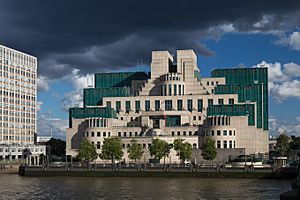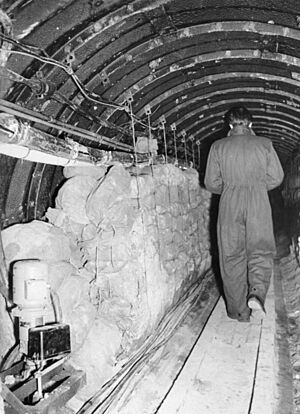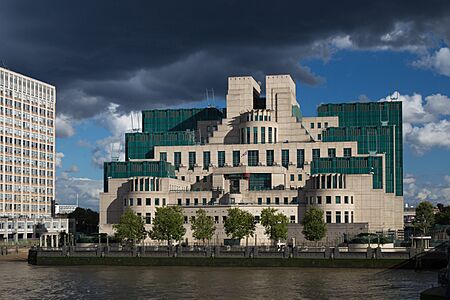MI6 facts for kids
 |
|
 SIS Building, the headquarters of MI6 in London |
|
| Agency overview | |
|---|---|
| Formed | 4 July 1909 |
| Preceding | |
| Type | Foreign intelligence service |
| Jurisdiction | His Majesty's Government |
| Headquarters | SIS Building London, England United Kingdom 51°29′14″N 0°7′27″W / 51.48722°N 0.12417°W |
| Motto | Semper Occultus ("Always Secret") |
| Employees | 3,644 |
| Annual budget | Single Intelligence Account £3.711 billion (2021–22) |
| Minister responsible | |
| Agency executive |
|
The Secret Intelligence Service (SIS), often called MI6, is the United Kingdom's foreign intelligence service. This means its main job is to secretly gather information in other countries. It helps protect the UK by understanding what is happening around the world.
MI6 is one of several British intelligence groups. The person in charge of MI6 is known as "C". They report to the Foreign Secretary. This is a senior government official who handles the UK's relationships with other countries.
The agency started in 1909 as part of the Secret Service Bureau. The name "MI6" became popular during World War II. It is still used today, especially in movies like the James Bond series. For a long time, the government did not officially say MI6 existed. This changed in 1994 when a law was passed that explained its role and legal powers.
Today, MI6 works to stop terrorism and prevent the spread of dangerous weapons. It also fights cyber threats. Unlike MI5, which works inside the UK, MI6 operates only in foreign countries. Since 1994, its main office has been the famous SIS Building in London.
Contents
What MI6 Does
The main goal of the Secret Intelligence Service (SIS) is to gather information from other countries. This information helps keep the United Kingdom safe. It also helps the British government make important choices about world events. This protects the country's security and economy.
SIS officers and agents work on secret missions all over the world. They often work with other UK agencies. These include MI5 (for security inside the UK) and GCHQ (for cyber intelligence).
SIS has three main jobs:
- Stopping Terrorism: They work to prevent terrorist attacks in the UK. They also protect British interests in other countries.
- Spying: They protect the UK's national security by finding out other countries' secrets.
- Cyber Security: They use technology to stop online threats. These threats can come from other countries or criminal groups.
By doing these jobs, MI6 helps protect the UK from harm. It also keeps the country's defenses strong.
How MI6 is Organised
Who is in charge?
The UK government controls SIS. The government makes the laws and provides the money MI6 needs. The Prime Minister is in charge of all intelligence and security. However, the Foreign Secretary manages MI6 day-to-day.
The head of MI6 is called the Chief, or "C". The Chief has two main duties. Inside MI6, they manage the agents. They also decide how to spend money and use technology for missions. Outside MI6, the Chief acts like a secret diplomat. They build relationships with intelligence agencies in other countries. Since 2020, Sir Richard Moore has been the Chief.
Joint Intelligence Committee
The Joint Intelligence Committee (JIC) is a very important group. It looks at information gathered by MI6, MI5, and GCHQ. The JIC then shares this intelligence with government ministers. This helps the government make smart decisions to protect the country.
History of MI6
How it all started
MI6 began in 1909 as the foreign part of the Secret Service Bureau. The Bureau was created by the Admiralty (in charge of the Royal Navy) and the War Office (in charge of the Army). Its main job was to watch what the German government was doing.
Soon, the Bureau split into two parts. One part focused on spying in other countries, which became MI6. The other part focused on catching foreign spies inside Britain, which became MI5.
The first director of MI6 was Captain Sir Mansfield Smith-Cumming. He would sign his letters with the initial "C" in green ink. This started a tradition. Every director of MI6 since then has been known by the codename "C".
The World Wars
During World War I, MI6 grew bigger. However, it was hard to get spies into Germany. Most of its information came from networks in neutral countries.
After the war, in the 1920s, MI6 began to focus on the threat of Communism. This was especially from the new Soviet Union. The agency also set up a passport control department. This gave its spies diplomatic cover. It meant agents could pretend to be diplomats. This gave them protection while working overseas.
When Nazi Germany became a threat in the 1930s, MI6 changed its focus. Its top goal was to gather information on the German air force, the Luftwaffe. Britain feared a bombing attack.
During World War II, other groups helped MI6's work. The most famous was the Government Code and Cypher School at Bletchley Park. The codebreakers there cracked Germany's secret Enigma code. The information from these broken codes was called "Ultra". It was very valuable to the Allies. This success gave MI6's chief, Stewart Menzies, a lot of power.
MI6 also worked closely with Polish intelligence agents. Polish spies gave a huge amount of information from inside Nazi-occupied Europe. They gave early warnings about German military plans. They even helped deliver the first reports about the Holocaust to the Allies.
The Cold War
After World War II, the world entered the Cold War. This was a long period of tension between the West and the Soviet Union. MI6's main focus became spying on the Soviets.
However, the agency had a big problem. One of its own senior officers, Kim Philby, was secretly a Soviet spy. He was part of a group called the Cambridge Five. They passed British secrets to the Soviets for years. This caused a lot of damage to MI6.
Despite this, MI6 had many successes. In the 1950s, it worked with the American CIA. They worked on Operation Gold. This was a plan to dig a secret tunnel into East Berlin. The goal was to listen to Soviet military phone lines. Another success was recruiting Oleg Penkovsky. He was a Soviet military intelligence colonel. He gave the West vital information during the Cuban Missile Crisis.
During the Soviet–Afghan War in the 1980s, MI6 supported the Afghan resistance fighters. They were led by Ahmad Shah Massoud. They were fighting against the Soviet army.
After the Cold War
When the Cold War ended around 1991, MI6 had to change. The Soviet Union was no longer the main threat. The agency began to focus on new problems. These included stopping the spread of nuclear weapons, fighting international crime, and terrorism.
In 1994, the Intelligence Services Act was passed. For the first time, this law officially recognized MI6 and GCHQ. It also set out the rules for their work. A new committee was also created in Parliament to oversee the intelligence agencies.
The War on Terror
After the September 11 attacks in 2001, MI6's focus shifted again. It began fighting global terrorism, especially groups like Al Qaeda. MI6 agents were sent to Afghanistan. They worked with local forces against the Taliban.
Before the 2003 invasion of Iraq, MI6 provided information about Iraq's weapons. However, this information later turned out to be wrong. This caused a lot of debate. In the years that followed, MI6 was involved in secret operations in Iraq, Afghanistan, and other places like Libya and Yemen.
Becoming an MI6 Agent
How are agents chosen?
MI6 looks for smart and talented people. They come from many different backgrounds, including universities and the military. To apply, you must be a British citizen.
First, applicants take a standard civil service exam. If they pass, they have a detailed interview with MI6 officers. After that, the agency does a very thorough background and security check. If the applicant passes all these steps, they are offered a job.
What is training like?
New recruits go through an intense six-month training course. They learn the skills of a spy, known as "tradecraft." This includes how to find and manage agents. They also learn how to work undercover and use secret communication methods.
MI6 agents also receive training in using firearms. However, it is very rare for an agent to carry or use a gun. They also get training from the United Kingdom Special Forces for working in dangerous situations.
How much do they earn?
As of April 2024, a new agent's starting salary was around £34,000 per year. Salaries increase with experience and promotions.
Famous MI6 Buildings
Since 1995, the headquarters of MI6 has been the SIS Building. It is at 85 Vauxhall Cross in London. It is a very unique green and cream-colored building. It sits on the south bank of the River Thames.
The building was designed to be super secure. It has protection against bombs. It also has advanced computer systems. It is protected against electronic spying. In 2000, the building was hit by an anti-tank rocket. However, it caused only minor damage.
MI6 in James Bond Films
The SIS Headquarters is famous for appearing in several James Bond films.
- In GoldenEye and The World Is Not Enough, it serves as Bond's main base. In The World Is Not Enough, a bomb explodes inside the building.
- In Skyfall, the building is attacked again. This time it is by a cyber-terrorist. This causes a massive explosion.
- In Spectre, the damaged building is set to be demolished. The villain, Ernst Stavro Blofeld, traps Bond inside and blows it up.
Other Buildings
- Fort Monckton: This is a historic fort in Hampshire. It is now used as the training center for new MI6 officers.
- Hanslope Park: This is a high-tech site near Milton Keynes. It provides communications support for MI6 and other government departments.
Chiefs of MI6
The head of MI6 is known as "C". Here is a list of some of the chiefs since 1909.
- 1909–1923: Sir Mansfield Smith-Cumming
- 1939–1952: Major General Sir Stewart Menzies
- 1956–1968: Sir Richard White
- 1989–1994: Sir Colin McColl
- 2004–2009: Sir John Scarlett
- 2020–present: Sir Richard Moore
Images for kids
See also
 In Spanish: MI6 para niños
In Spanish: MI6 para niños
- British intelligence agencies
- List of intelligence agencies
- History of espionage
- Camp X, a training facility in Canada for secret agents during WWII





